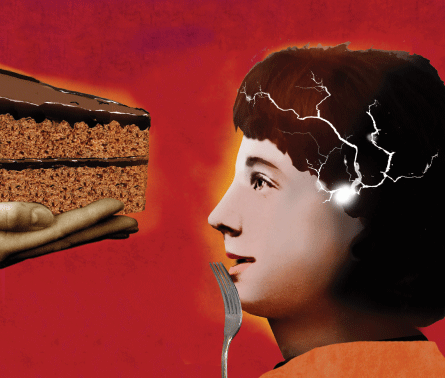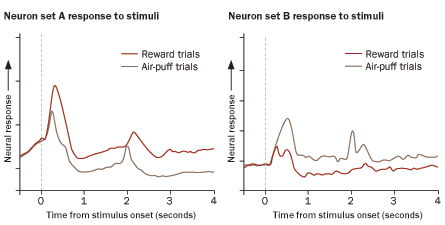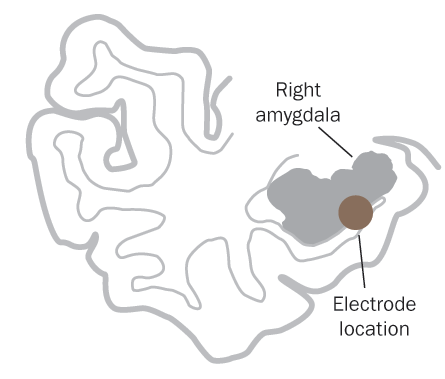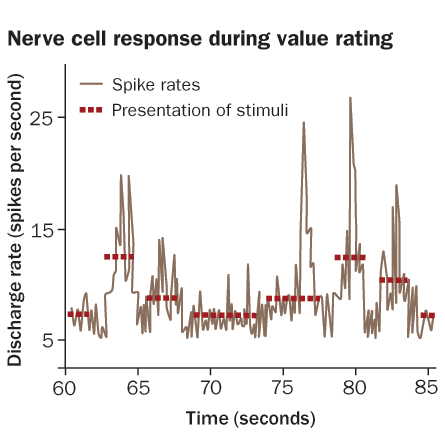Cerebral Delights
The amygdala, a part of the brain known for its role in fear, also helps people spot rewards — and go after them
You know the feeling — the flush of excitement when your boss hands you a bonus check, or you unexpectedly run into an old friend, or you discover a way to get tickets to the big game that was long ago sold out. When life throws you a gift or a gain, it’s not just your mood that perks up. Two small almond-shaped masses of nerve cells buried deep in your brain take notice too.




Those clumps of cells, one on each side of the brain, are known as the amygdala (uh-MIG-duh-luh). For years the amygdala has been regarded primarily as the brain’s center for fear. Scores of studies have shown that it is essential both for perceiving fear and expressing it.
In recent years, though, a surge of new research has expanded scientists’ view of the amygdala’s importance. It turns out that the amygdala helps shape behavior in response to all sorts of stimuli, bad and good. It plays a role not only in aversion to fright, but also in pursuit of pleasure.
Studies of the brain’s anatomy reveal good reasons for the amygdala’s power: It is very well connected. In humans and other primates, the amygdala is linked through a complex network of cells to brain regions involved in all five senses. Signals about everything you encounter are passed from the brain’s sensory processing areas directly to the amygdala. And the amygdala shares elaborate communications channels with the prefrontal cortex — the brain’s control center for planning and decision making.
Its strategic location allows the amygdala to act as a spotlight, calling attention to sensory input that is new, exciting and important. In this way, it helps predict the timing and location of potential dangers, helping you dodge many of the things you dread. But those same connections also help you acquire the good things in life, by identifying and assessing rewards such as food, sex and other delights.
Though much more is known about its fear job, researchers are now vigorously gathering evidence about how the amygdala evaluates information and events for their reward potential. Recent studies offer clues to how the amygdala assigns value to rewards and adjusts that value as circumstances change. Other work provides insights into how the amygdala links actions and rewards, suggesting that the amygdala plays a role in goal-directed behavior. Still others are finding out how neural circuits in the highly connected human amygdala work with other brain structures to recognize good things and find ways to get them.
Such studies may help scientists understand how rewards can sway attention or learning and help people make choices. Recent results may also lead to new therapies for those suffering from depression and anxiety disorders, as well as providing insights into reward-seeking behaviors such as addiction.
Recognizing reward
The amygdala is part of the limbic system, a primitive set of brain structures involved in emotion and arousal. Studies going back to the mid-1950s show that the amygdala, located near the hippocampus in the front part of the temporal lobe, serves as a type of watchdog to identify potential threats and danger. Because it is highly interconnected with the senses, the amygdala can take in danger signals — the sight of a snake or the sound of a gunshot — and flash messages almost instantly through the nervous system, alerting the body to respond. Chemical messengers are then released into the bloodstream to ready a flight-or-fight response, providing the energy needed to run faster or hit harder.
Early humans relied on this system to avoid all types of deadly threats, from saber-toothed tigers to falling trees.
But being able to identify potential rewards is also crucial for survival, says Elisabeth Murray, a neurobiologist at the National Institute of Mental Health in Bethesda, Md. People, and other animals, face countless reward-related decisions as they go about their daily business, foraging for food, finding mates and passing on genes. Identifying pleasant situations and avoiding aversive ones can boost well-being and chances for survival.
Murray says many scientists are now coming to understand that at least part of that reward-based behavior is driven by some sort of interaction between the amygdala and the frontal lobe, known to be involved in thought, memory and consciousness. Her lab is especially interested in circuits connecting the amygdala with the orbitofrontal cortex, a part of the prefrontal cortex that sits just behind the eyes.
“Those parts of the brain are anatomically interconnected, and we think that they’re interconnected in this way to help animals make good decisions,” Murray says.
In recent years, Murray and others have initiated studies to better understand how the amygdala processes information that feeds into decisions.
In 2006, researchers at Columbia University provided a clue, showing how the amygdala judges the emotional value of stimuli. A team led by C. Daniel Salzman taught monkeys to associate two patterns on a TV monitor with either a rewarding sip of water or an irksome puff of air to the face. By recording the electrical activity in the amygdala as animals watched the screen, the scientists showed that different amygdala nerve cells are tuned to handle positive and negative events.
In a follow-up experiment with a slightly different setup, Salzman’s group found that a set of nerve cells is specifically tuned for processing surprise. Some among those nerve cells were dedicated solely to the rewarding surprise, the water sip.
“These neurons were not registering whether something aversive was surprising,” Salzman says, suggesting they play a specialized role in rewarding surprises.
Other amygdala neurons did the opposite — registering surprise when it was aversive but not rewarding. By carrying two different sets of neurons for surprise, the amygdala may be better able to predict what’s coming in order to prepare appropriate actions, Salzman says.
“If you get something that’s highly rewarding by surprise, you want to be able to take actions in advance that would help you acquire that rewarding stimulus again,” he says. “By contrast, if you receive a bad surprise you normally would want to take some defensive actions or avoidance actions to avert a similar outcome.”
Ensuring a good hand
But the same stimulus, depending on the circumstances, can be rewarding or not, Salzman explains. He uses an example from the card game blackjack.
The object of the game is to hold cards with a total value as close as possible to 21, without going over. Players are initially dealt two cards and then can request additional cards.
Say a player is dealt two cards with a total value of 11 and then gets a 10 of hearts, worth 10 points, to reach a perfect 21. Now suppose that in the next hand, after the cards are shuffled, the same player is dealt two cards that total 15. The third card reveals the exact same 10 of hearts. While golden in the first hand, the 10 becomes an unfortunate deal the second time around. Most people would have no difficulty recognizing this point, Salzman says, evidence that the amygdala’s emotional response to the same sensory stimulus can be flexible.
Murray sees such flexibility among monkeys making food choices in the lab. Given a choice between two foods, monkeys (like most people) will invariably reach for their favorite. But after gorging on a favored food for a while, the reward value of that treat diminishes, the way the value of the 10 drops when a blackjack player already has 15 points in hand. At that point the monkeys shift their choices and select a new food.
Monkeys without a working amygdala, however, show little change in behavior and continue to stuff themselves with the first food choice, Murray’s studies have found. These findings suggest that the amygdala is needed to revise the assessment of a reward’s value.
“What we think is happening is that the amygdala is helping update the food value, and sending that information somewhere else — probably the orbitofrontal cortex,” Murray says. This same circuitry may also help animals, including humans, automatically calculate and update the value of goals or outcomes on the fly. “If you’re an animal out there and you’ve just learned something about either a harmful stimulus or a predator, you may not get a second chance.”
Murray’s group is now using a similar method to see how values assigned to various rewards can be linked with actions. In a recent experiment, Sarah Rhodes, also of the National Institute of Mental Health, trained monkeys to perform two actions, tap and hold, to receive a reward. Six rapid taps to a touch-sensitive screen were rewarded with one kind of food, while a continuous touch for two seconds was rewarded with another.
Rhodes, Murray and their colleagues wanted to see if the animals, once filled with their favorite food, would shift their actions along with their choices. Normal monkeys did, choosing a new action once they got their fill of the first food. Animals without an amygdala, however, didn’t make the switch.
Those findings, reported in November in San Diego at the annual meeting of the Society for Neuroscience, suggest that the intact control animals engaged in goal-directed behavior, and that the amygdala played a role, Murray says.
“It means the animals literally know and somehow represent a goal. And that if the value of the goal changes, they can therefore change their behavior,” she says. “We think this is what humans do, so it’s really helpful to understand the neural circuitry.”
Another recent study shows that people, like monkeys, do indeed use the amygdala to judge the value of a particular item. Rick Jenison, who studies neuroeconomics at the University of Wisconsin–Madison, and his colleagues recruited three volunteers who were already undergoing a procedure that required electrodes to be implanted in the brain. Using the electrodes, the researchers eavesdropped on 51 amygdala nerve cells as the volunteers put price tags on a series of junk food items.
Listening in on nerve cell chatter, Jenison’s group found 16 individual cells that responded in a way consistent with the values that participants assigned to individual foods. The study, published January 5 in the Journal of Neuroscience, is the first to show how single neurons in the human amygdala work to assess the value of an object (SN: 1/29/11, p. 8). In addition, the study shows how amygdala neurons compute value in real time, while decisions are being made.
“These findings suggest that the human amygdala’s involvement in decision making happens at the time of the choice and is not restricted to familiar situations,” he says.
Many of the animal studies, on the other hand, are based on learned tasks, so value could be assigned over a number of trials, Jenison says.
Using functional MRI to map the location of the electrodes, Jenison’s group created an anatomical map showing the precise location of the value-coding neurons. Such information may serve as a starting point in figuring out how such neurons connect to other structures in the brain.
Because value-coding neurons in the amygdala intermingle with neurons that do other things, sorting out connections could be crucial for understanding how people respond to particular cues, says neuroscientist Patricia Janak of the University of California, San Francisco, who studies the amygdala’s role in reward and addiction. “The idea would be to see where those [value-coding] neurons are going, and then hence what behavior they affect,” she says.
Untangling connections
While recent studies show that the amygdala plays a role in assigning value to actions or things, other findings show that parts of the prefrontal cortex also signal what things are worth.
“We were really interested to know: Is the amygdala the thing which supplies that value information or is it the other way around — the prefrontal cortex that tells the amygdala?” says Peter Rudebeck, a postdoc in Murray’s lab. “The anatomy suggests that it’s the amygdala telling these other parts of the brain what these certain things are worth. But we wanted to test that.”
Rudebeck and his group trained monkeys to play a computer game in which they assessed the value of different rewards. The animals were shown two different pictures and allowed to choose between them. One picture brought a large juice reward, and the other brought a much smaller amount of juice. The animals chose the picture associated with the larger reward more than 98 percent of the time.
After turning off the amygdala in some animals, the scientists used single-cell recordings to listen in on brain cell chatter in the orbitofrontal cortex and anterior cingulate cortex. To the team’s surprise, the monkeys still chose the picture with the “best” outcome on pretty much every trial, just as they had done with a working amygdala.
Though the animals continued choosing in the same manner, the scientists found that fewer neurons in the anterior cingulate cortex changed their firing rate in response to an expected reward. When looking at the animals’ emotional responses — as measured by pupil diameter and heart rate — researchers found that monkeys without a working amygdala didn’t react to a reward in the typical way, Rudebeck says. “They seemed to have no idea of what reward was, despite the fact that they could still choose perfectly well.”
The findings, reported at the neuroscience meeting, suggest that the brain uses various mechanisms to calculate how much something is worth. While the amygdala may be important for assigning an emotional value, Rudebeck says, it may not be the “be-all and end-all” in valuing objects. “I’m kind of glad that the brain isn’t as simple as we sometimes make it out to be,” he says.
By understanding how the amygdala guides reward-based behavior, scientists hope to someday reap rewards of their own. A deeper knowledge of the neural circuitry that regulates emotional responses may help scientists understand what goes awry in addiction and may allow scientists to find new ways to intervene in times of distress.
New discoveries could lead to medications and therapies designed to treat mood disorders such as depression, where stimuli that were previously pleasing aren’t anymore, says Salzman.
The studies also hold hope for developing new therapies for anxiety disorders, phobias and panic disorders that involve stimuli that can generate emotional responses even when they are presented in a nontraumatic situation.
“I believe that the best generation of psychiatric treatments is still to come,” Salzman says. “And it will ultimately be based on elucidation of the interconnected circuitry involving the amygdala, the prefrontal cortex and other brain structures.”
SOURCE: C.D. Salzman and S. Fusi/Annual Review of Neuroscience 2010
Sidebar: Linked in
Two clumps of cells, one on each side of the brain, the amygdala has many connections with parts of the prefrontal cortex and brain areas involved in the senses.
1. As the brain’s command center, the prefrontal cortex is responsible for making social choices, predicting future events, planning behavior and controlling emotions.
2. A part of the prefrontal cortex, the orbitofrontal cortex appears to be active during sensory integration and decision making.
3. The anterior cingulate cortex plays a role in attention, motivation and error detection.
4. The amygdala’s central nucleus is involved in fear responses, including freezing in place, rapid heartbeat and increased respiration. It is also linked with stress-hormone release.
5. After receiving information from the senses, the lateral nucleus forms associations with memories.
6. Clusters of nerve cells, the basal nuclei and accessory basal nuclei are responsible for body movement and coordination.
7. The intercalated masses are cell groups thought to play a role in emotional learning and memory.
8. The hippocampus plays an important part in learning and memory.